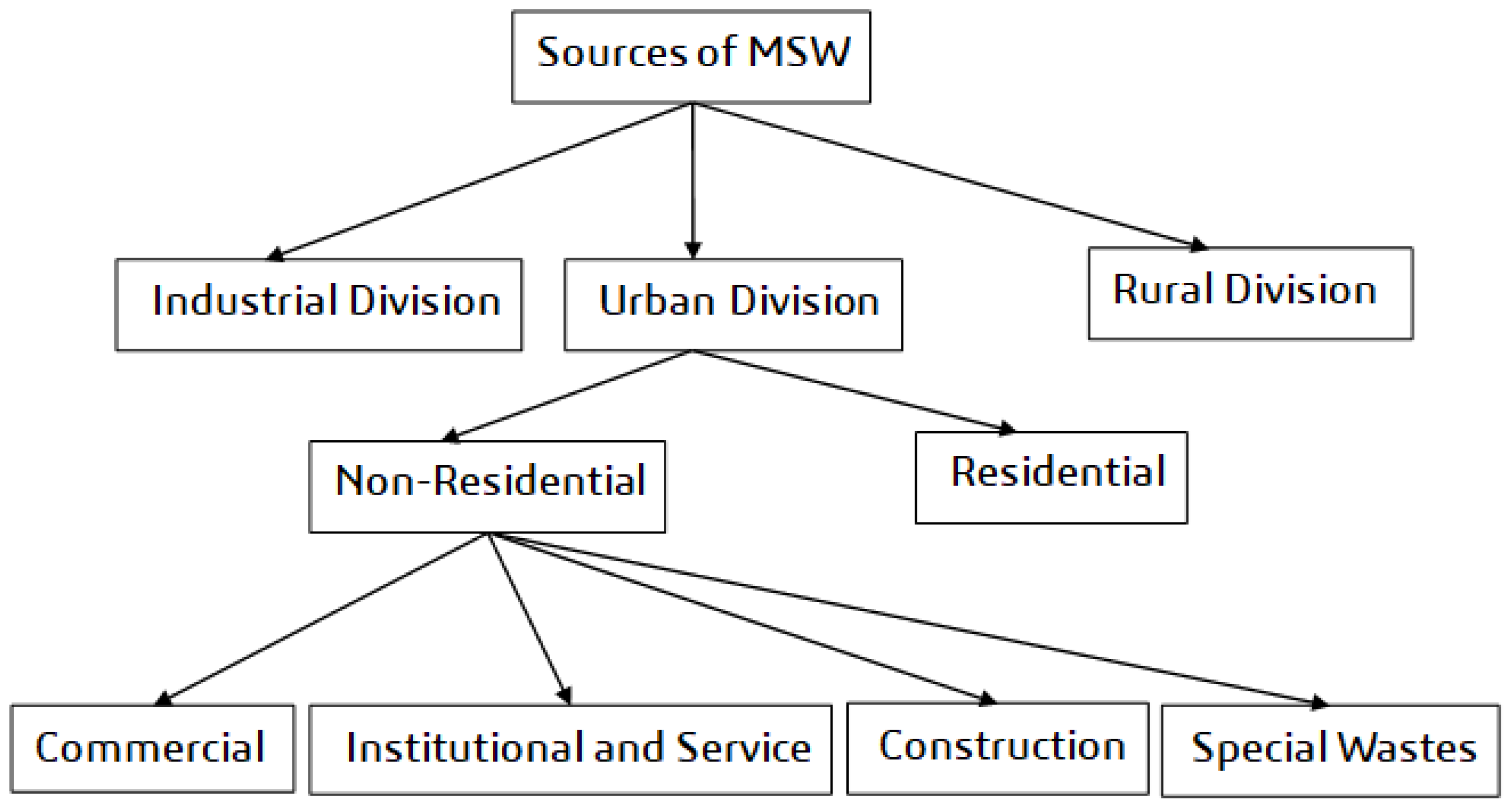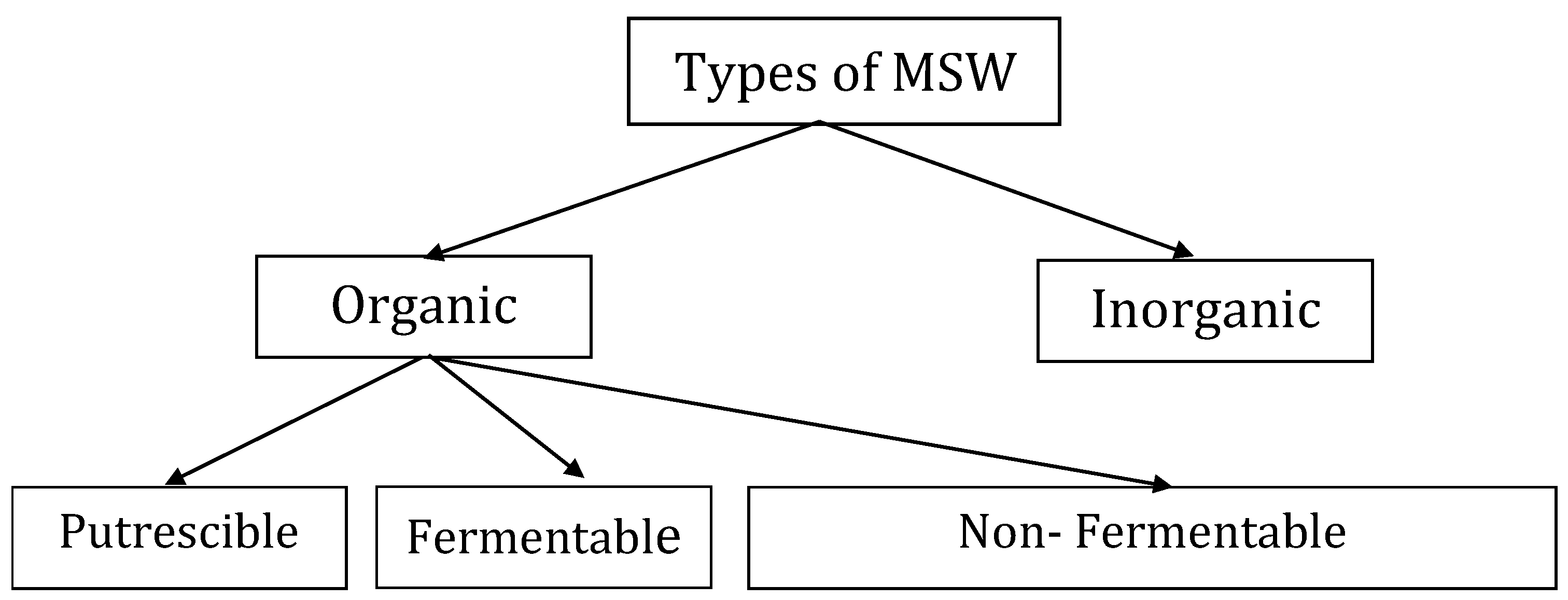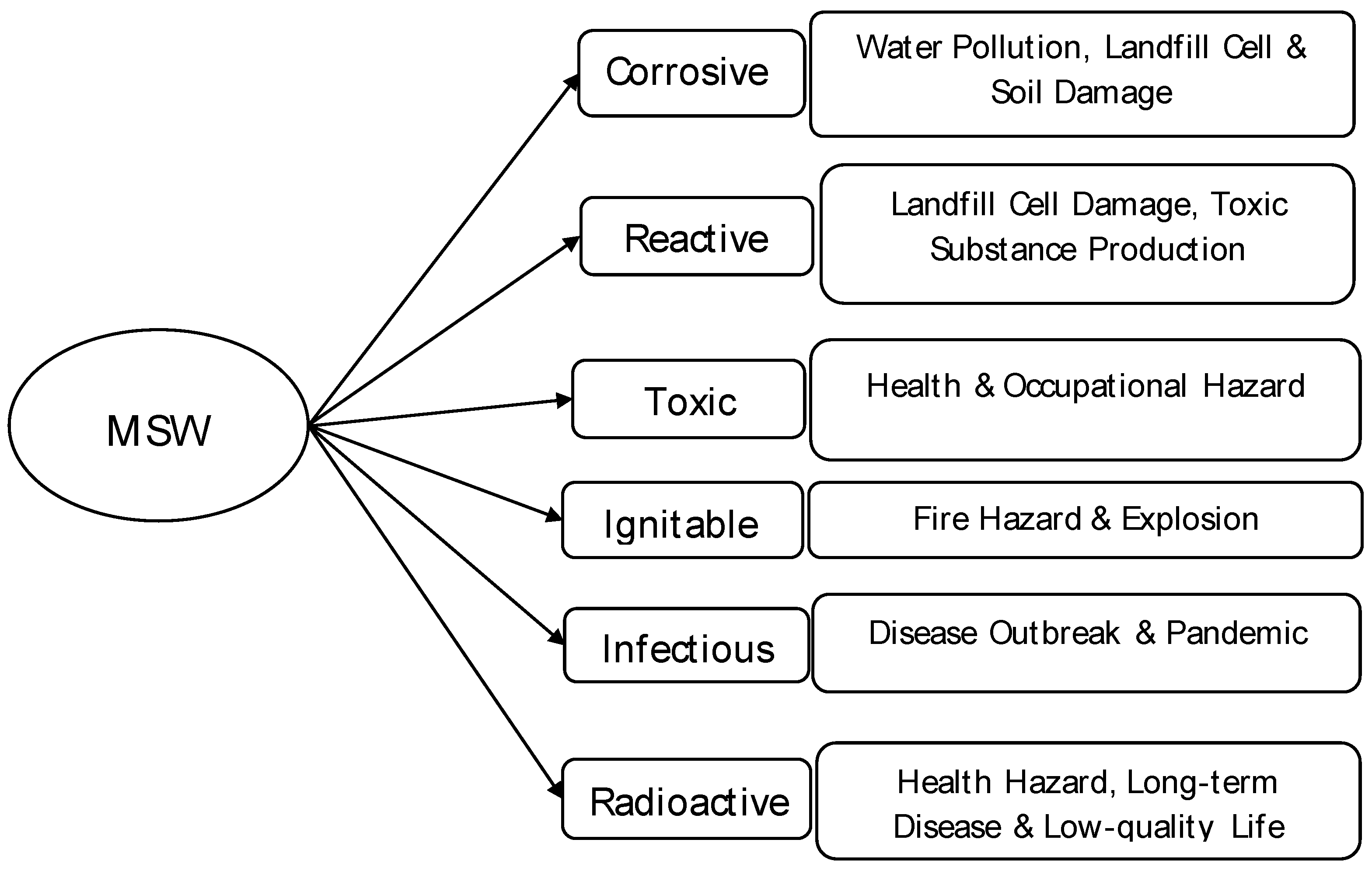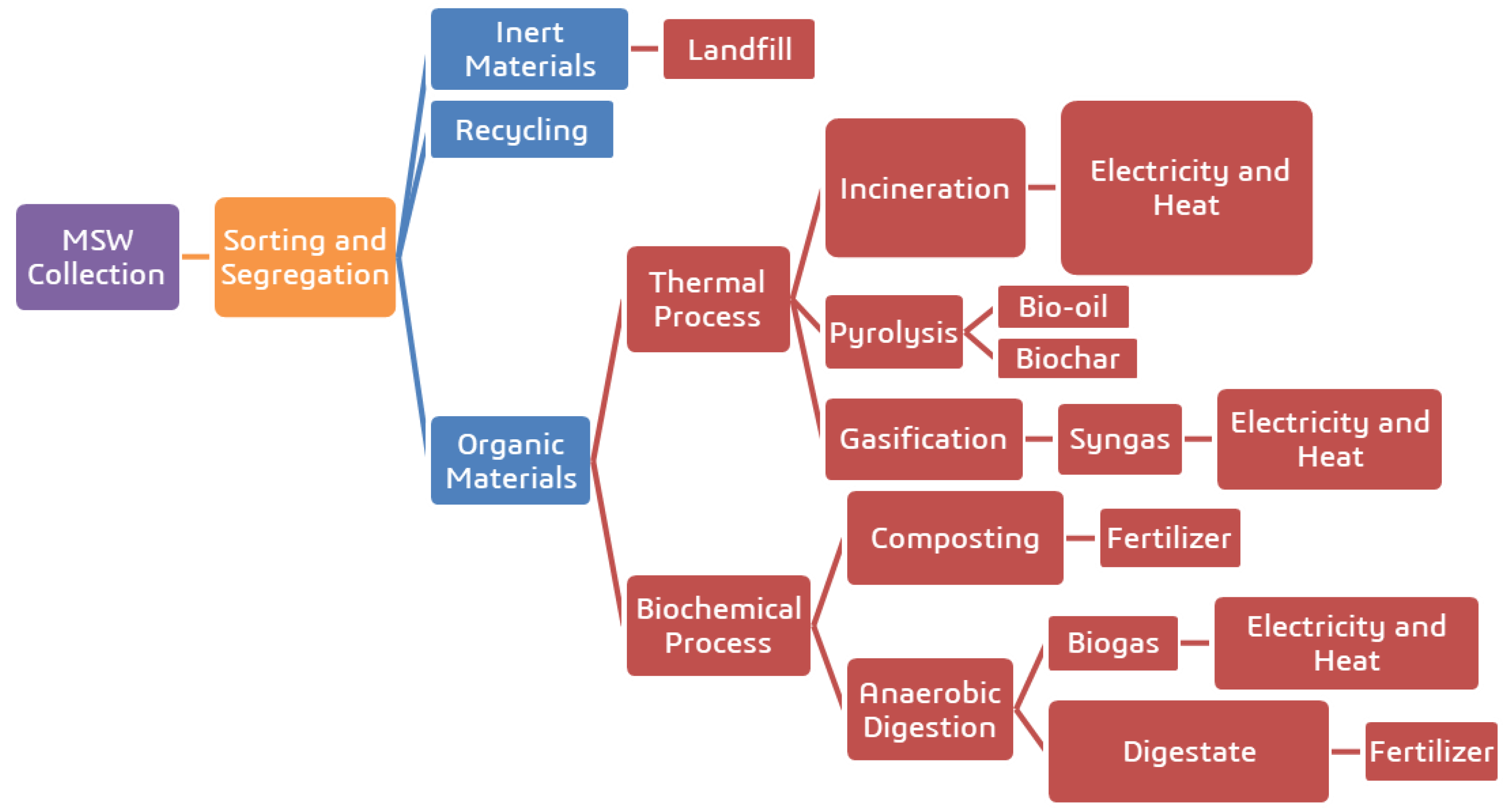Municipal solid waste (MSW) management has become a major concern for developing countries. The physical and chemical aspects of MSW management and infrastructure need to be analyzed critically to solve the existing socio-economic problem. Depending on the socio-economic framework of a country, several MSW management procedures have been established, including landfilling, thermal treatment, and chemical treatment. Most of the MSW produced in underdeveloped and developing countries such as Bangladesh, India, and Pakistan is dumped into open landfills, severely affecting the environment. Waste-to-Energy (WTE) projects based on thermal treatments, e.g., incineration, pyrolysis, and gasification, can be feasible alternatives to conventional technologies.
- MSW management
- landfills
- pyrolysis
- WTE
1. Introduction
2. MSW Characteristics
The sources of MSW, physical and chemical components are the critical parameters for proper MSW management, treatment, and disposal [13]. The origins of MSW can be classified into three main categories, e.g., urban, industrial and rural. Subclassification of MSW can be derived and represented in a hierarchy (Figure 1). The urban division consists of residential and non-residential wastes, e.g., commercial wastes, institutional/service wastes, construction wastes, and special types of waste. The wastes related to scientific experiments, medical, manufacturing, automobile maintenance shops, pharmacies, and airports are special waste. Industrial waste is generated in industrial sites. Extraction, utilization, modification, and production of goods and services, as well as the delivery of goods, residues, and effluent, fall into this category. Agriculture items, e.g., fertilizers, animal by-products, animal husbandry, etc., create waste termed a rural division [14].


3. MSW Collection and Transportation
A key component of sustainable MSW management is the collection of solid waste systematically. The existence of an organized collection system is essential for the efficient flow of waste management [16]. Several factors affect waste collection in developing and developed countries. Less developed and developing countries lack proper waste collection guidelines, which impacts waste management flow and leads to illegal and unsustainable practices, e.g., open incineration, open dumping at banned places, and backyard burning. In lesser developed and developing countries compared to developed countries, these practices are prevalent and result in significant adverse environmental health impacts due to the emission of toxic gases and the spread of diseases from open dumping. Whilst the infrastructure is well developed in developed countries; this is not the case in lesser developed and developing countries where the roads are in bad conditions or inaccessible [17]. In most cases, the waste collection vehicles cannot access areas for waste collection, and wastes remain at their sources of generation for a longer time. Another problem is the lack of financial resources to buy proper equipment and machinery for the generators to store their wastes; these services are expensive for municipalities in lesser developed and developing countries compared to developed countries [18]. Accordingly, waste generators resort to indiscriminate dumping in open spaces or water bodies and littering. Moreover, in lesser developed and developing countries, waste collection machinery and equipment are outdated, used without proper maintenance and suffer from breakdowns [19]. As a result, these factors affect waste transfer and transportation in less developed and developing countries than in developed countries. Due to a lack of proper knowledge and inefficient implementation of government policies, approximately 40–60% of the generated waste is not properly collected or disposed of in Bangladesh [20]. Residential waste is mostly stored in containers inside or house premises. Designated waste collectors come in a suitable time and collect waste from the containers. They mostly dispose of household waste in their container to carry the waste to the dumping site. Unfortunately, all kinds of waste are dumped together without separation. Some NGOs provide labelled trash bins in urban areas to solve this problem. Waste collection workers are not available in some areas. In that case, residents have to go to the dumping sites. The lack of workforce provided by the authority causes this problem for the residents. Different cities in Bangladesh show a variation in the MSW collection procedure. Authorities of Rajshahi and Chittagong participate in collecting waste from residents. In Khulna, the private sector has handled door-to-door pickups and whole ward management for the past ten years. Secondary disposal site (SDS) is an open area where the side of the road collects a pile of solid waste. They consist of sizable bins, massive steel transport containers, roadside free spaces, etc. According to the current municipal corporation laws, the authority is fully accountable for providing SDS in cities, collecting waste from them, and transportation to the disposal point. Disposal points are mostly based on the population of the area, space available in the place, distance from the city and transportation system. The overall numbers of SDS and community bins in the largest cities of Bangladesh are not satisfactory. Alternative possibilities for SDS should be taken into consideration since effective management with extremely precise time for collection and transfer is essential because SDS is generally located at busy locations. Sylhet City Corporation has already taken steps in this matter and has removed some roadside waste collection points. Dhaka and Khulna City Corporation has already made plans for experimental transfer stations. Just like the storage and collection of waste, transportation is equally important for fast and safe disposal. The transportation system of waste solely depends on the city authorities as NGOs take part in the collection of waste and storing them in SDS only. But some private companies under the instructions of city corporations have been involved in transportation in Dhaka and Khulna. Several collecting vehicles, mostly trucks, are stationed on the roadside next to SDS. Every vehicle has staff members who are assigned to collect and disposing waste. Waste is often collected throughout the day, impeding traffic and hauled through crowded areas, causing annoyance and pollution. These problems are mostly caused by an insufficient number of vehicles and manpower.4. MSW Management Techniques
MSW can be transformed into energy-producing and economic resources by employing appropriate waste management techniques [21]. The MSW management techniques depend on multiple factors, e.g., geography, economic development, demography, etc., throughout the world [22]. In low-income and middle-income countries, due to a lack of proper waste management systems, most waste disposal is carried out in the form of open dumping [23]. Incineration is also widely practiced in developing countries for waste volume reduction and power generation [24]. Figure 4 represents different processing techniques of MSW. Landfilling and thermal treatment of MSW are more common in high-income countries [25]. Currently, various WTE and waste conversion techniques are being employed worldwide to maximize the utilization of MSW and ensure its proper disposal. As urbanization expands, the environmental impact of waste management is becoming more important [26].

4.1. Landfilling
4.2. Thermal Process
The thermal process of MSW management includes incineration, pyrolysis, and gasification. Incineration can be carried out by mass combustion, co-combustion with coal or biomass, refuse-derived fuel (RDF), etc. [47]. By mass combustion, the unsorted MSW is usually completely oxidized, generating energy and producing flue gas, ash, and liquid discharge, thereby reducing the waste volume by 90% [48]. Although the volume is reduced, the new forms of waste, i.e., bottom ash, fly ash, flue gas, and liquid discharge, are harder to deal with and harmful to the environment. This process is also less feasible for developing countries where the organic fraction of waste is higher [34]. During combustion, the combustible materials in the waste come into contact with oxygen at high temperatures (usually 850 °C to 1450 °C) and go through an oxidation reaction releasing heat energy [49]. Incineration plants that generate electricity have efficiencies of up to 20%, while plants that use cogeneration of thermal power and electricity generation have efficiencies of up to 80%. Pre-processing of solid waste prior to incineration through advanced separation, biological and thermal waste treatment, and other methods have been shown to increase the efficiency of the incineration process [50]. Screening solid waste allows for the separation of reusable materials (plastics, paper fibers, and metals) as well as the reduction of the presence of hazardous/toxic materials in the waste [50]. Treatment processes such as torrefaction, shredding and size reduction of the MSW before incineration increase the heating value and reduce the pollution factor [51]. For MSW treatment, pyrolysis is another technique [52]. It is a thermal degradation process in which large chain hydrocarbons (primarily from plastics and polymers in MSW) are cracked in the absence of oxygen at temperatures ranging from 300 °C to 600 °C. This method produces combustible gas (syngas), liquid bio-oil, tar, and char [53] (Figure 6).
4.3. Biochemical Conversion
References
- Pop, M.; Bucur, I.; Zoldan, D.; Imre, K.; Nichita, I.; Cristina, G.; Tîrziu, A.; Tîrziu, E. Chemical and Microbiological Air Quality in a Municipal Solid Waste Landfill and Its Surroundings, in South-Eastern Romania. Sustainability 2022, 14, 156.
- Khan, A.H.; Sharholy, M.; Alam, P.; Al-Mansour, A.I.; Ahmad, K.; Kamal, M.A.; Alam, S.; Pervez, M.N.; Naddeo, V. Evaluation of cost benefit analysis of municipal solid waste management systems. J. King Saud Univ.-Sci. 2022, 34, 101997.
- Gabay, M. Resource Conservation and Recovery Act: Management of Pharmaceutical Waste. Hosp. Pharm. 2012, 47, 769–770.
- Gundupalli, S.P.; Hait, S.; Thakur, A. A review on automated sorting of source-separated municipal solid waste for recycling. Waste Manag. 2017, 60, 56–74.
- Kaza, S.; Yao, L.; Bhada-Tata, P.; Van Woerden, F. What a Waste 2.0: A Global Snapshot of Solid Waste Management to 2050; Urban Development; The World Bank: Washington, DC, USA, 2018; 292p.
- Jerin, D.T.; Sara, H.H.; Radia, M.A.; Hema, P.S.; Hasan, S.; Urme, S.A.; Audia, C.; Hasan, M.T.; Quayyum, Z. An overview of progress towards implementation of solid waste management policies in Dhaka, Bangladesh. Heliyon 2022, 8, e08918.
- Kawai, K.; Tasaki, T. Revisiting estimates of municipal solid waste generation per capita and their reliability. J. Mater. Cycles Waste Manag. 2016, 18, 1–13.
- Habib, M.A.; Ahmed, M.M.; Aziz, M.; Beg, M.R.A.; Hoque, M.E. Municipal Solid Waste Management and Waste-to-Energy Potential from Rajshahi City Corporation in Bangladesh. Appl. Sci. 2021, 11, 3744.
- D’Adamo, I.; Gastaldi, M.; Rosa, P. Recycling of end-of-life vehicles: Assessing trends and performances in Europe. Technol. Forecast. Soc. Change 2020, 152, 119887.
- Rada, E.C.; Ragazzi, M.; Fedrizzi, P. Web-GIS oriented systems viability for municipal solid waste selective collection optimization in developed and transient economies. Waste Manag. 2013, 33, 785–792.
- Guerrero, L.A.; Maas, G.; Hogland, W. Solid waste management challenges for cities in developing countries. Waste Manag. 2013, 33, 220–232.
- Kumar, A.; Agrawal, A. Recent trends in solid waste management status, challenges, and potential for the future Indian cities—A review. Curr. Res. Environ. Sustain. 2020, 2, 100011.
- Iqbal, M.R.; Piumali, A.B.K.T.; Priyankara, N.H.; Alagiyawanna, A.M.N.; Kurukulasuriya, L.C.; Kawamoto, K. Characterization of Physicochemical and Mechanical Properties of Dumped Municipal Solid Waste in Sri Lanka as Affected by the Climate Zone and Dumping Age. Sustainability 2022, 14, 4706.
- Buenrostro, O.; Bocco, G.; Cram, S. Classification of sources of municipal solid wastes in developing countries. Resour. Conserv. Recycl. 2001, 32, 29–41.
- Ziraba, A.K.; Haregu, T.N.; Mberu, B. A review and framework for understanding the potential impact of poor solid waste management on health in developing countries. Arch. Public Health 2016, 74, 55.
- dos Muchangos, L.S.; Tokai, A.; Hanashima, A. Analyzing the structure of barriers to municipal solid waste management policy planning in Maputo city, Mozambique. Environ. Dev. 2015, 16, 76–89.
- Hoornweg, D.; Bhada-Tata, P. What a Waste: A Global Review of Solid Waste Management; The World Bank Group: Washington, DC, USA, 2012.
- Mohee, R.; Mauthoor, S.; Bundhoo, Z.M.; Somaroo, G.; Soobhany, N.; Gunasee, S. Current status of solid waste management in small island developing states: A review. Waste Manag. 2015, 43, 539–549.
- Bohdziewicz, J.; Kwarciak, A. The application of hybrid system UASB reactor-RO in landfill leachate treatment. Desalination 2008, 222, 128–134.
- Ahsan, A.; Alamgir, M.; El-Sergany, M.M.; Shams, S.; Rowshon, M.K.; Daud, N.N. Assessment of Municipal Solid Waste Management System in a Developing Country. Chin. J. Eng. 2014, 2014, 561935.
- Islam, K.M.N. Municipal Solid Waste to Energy Generation in Bangladesh: Possible Scenarios to Generate Renewable Electricity in Dhaka and Chittagong City. J. Renew. Energy 2016, 2016, 1712370.
- Hemidat, S.; Achouri, O.; El Fels, L.; Elagroudy, S.; Hafidi, M.; Chaouki, B.; Ahmed, M.; Hodgkinson, I.; Guo, J. Solid Waste Management in the Context of a Circular Economy in the MENA Region. Sustainability 2022, 14, 480.
- Nanda, S.; Berruti, F. Municipal solid waste management and landfilling technologies: A review. Environ. Chem. Lett. 2021, 19, 1433–1456.
- Lee, C.C.; Huffman, G.L. Incineration of solid waste. Environ. Prog. 1989, 8, 143–151.
- Ferronato, N.; Torretta, V. Waste Mismanagement in Developing Countries: A Review of Global Issues. Int. J. Environ. Res. Public Health 2019, 16, 1060.
- Deus, R.M.; Mele, F.D.; Bezerra, B.S.; Battistelle, R.A.G. A municipal solid waste indicator for environmental impact: Assessment and identification of best management practices. J. Clean. Prod. 2020, 242, 118433.
- Mukherjee, C.; Denney, J.; Mbonimpa, E.G.; Slagley, J.; Bhowmik, R. A review on municipal solid waste-to-energy trends in the USA. Renew. Sustain. Energy Rev. 2020, 119, 109512.
- Cucchiella, F.; D’Adamo, I.; Gastaldi, M. Sustainable waste management: Waste to energy plant as an alternative to landfill. Energy Convers. Manag. 2017, 131, 18–31.
- Suthar, S.; Rayal, P.; Ahada, C.P.S. Role of different stakeholders in trading of reusable/recyclable urban solid waste materials: A case study. Sustain. Cities Soc. 2016, 22, 104–115.
- Lu, J.S.; Chang, Y.; Poon, C.S.; Lee, D.J. Slow pyrolysis of municipal solid waste (MSW): A review. Bioresour. Technol. 2020, 312, 123615.
- Malkow, T. Novel and innovative pyrolysis and gasification technologies for energy efficient and environmentally sound MSW disposal. Waste Manag. 2004, 24, 53–79.
- Paritosh, K.; Yadav, M.; Mathur, S.; Balan, V.; Liao, W.; Pareek, N.; Vivekanand, V. Organic Fraction of Municipal Solid Waste: Overview of Treatment Methodologies to Enhance Anaerobic Biodegradability. Front. Energy Res. 2018, 6, 75.
- Şimşek, K.; Alp, S. Evaluation of Landfill Site Selection by Combining Fuzzy Tools in GIS-Based Multi-Criteria Decision Analysis: A Case Study in Diyarbakır, Turkey. Sustainability 2022, 14, 9810.
- Narayana, T. Municipal solid waste management in India: From waste disposal to recovery of resources? Waste Manag. 2009, 29, 1163–1166.
- Kalyani, K.A.; Pandey, K.K. Waste to energy status in India: A short review. Renew. Sustain. Energy Rev. 2014, 31, 113–120.
- Sohoo, I.; Ritzkowski, M.; Sultan, M.; Farooq, M.; Kuchta, K. Conceptualization of Bioreactor Landfill Approach for Sustainable Waste Management in Karachi, Pakistan. Sustainability 2022, 14, 3364.
- Wiszniowski, J.; Robert, D.; Surmacz-Gorska, J.; Miksch, K.; Weber, J.V. Landfill leachate treatment methods: A review. Environ. Chem. Lett. 2006, 4, 51–61.
- Youcai, Z. Chapter 1—Leachate Generation and Characteristics. In Pollution Control Technology for Leachate from Municipal Solid Waste; Youcai, Z., Ed.; Butterworth-Heinemann: Oxford, UK, 2018; pp. 1–30.
- Tałałaj, I.A.; Biedka, P.; Bartkowska, I. Treatment of landfill leachates with biological pretreatments and reverse osmosis. Environ. Chem. Lett. 2019, 17, 1177–1193.
- Kjeldsen, P.; Barlaz, M.A.; Rooker, A.P.; Baun, A.; Ledin, A.; Christensen, T.H. Present and Long-Term Composition of MSW Landfill Leachate: A Review. Crit. Rev. Environ. Sci. Technol. 2002, 32, 297–336.
- Chelliapan, S.; Arumugam, N.; Din, M.F.M.; Kamyab, H.; Ebrahimi, S.S. Chapter 11—Anaerobic treatment of municipal solid waste landfill leachate. In Bioreactors; Singh, L., Yousuf, A., Mahapatra, D.M., Eds.; Elsevier: Amsterdam, The Netherlands, 2020; pp. 175–193.
- Alvarez-Vazquez, H.; Jefferson, B.; Judd, S.J. Membrane bioreactors vs. conventional biological treatment of landfill leachate: A brief review. J. Chem. Technol. Biotechnol. 2004, 79, 1043–1049.
- Akter, S.; Suhan, M.B.K.; Islam, M.S. Recent advances and perspective of electrocoagulation in the treatment of wastewater: A review. Environ. Nanotechnol. Monit. Manag. 2022, 17, 100643.
- Foo, K.Y.; Hameed, B.H. An overview of landfill leachate treatment via activated carbon adsorption process. J. Hazard. Mater. 2009, 171, 54–60.
- Kurniawan, T.A.; Lo, W.-H.; Chan, G.Y.S. Physico-chemical treatments for removal of recalcitrant contaminants from landfill leachate. J. Hazard. Mater. 2006, 129, 80–100.
- Zhang, Q.; Lu, H.; Liu, J.; Wang, W.; Zhang, X. Hydraulic and mechanical behavior of landfill clay liner containing SSA in contact with leachate. Environ. Technol. 2018, 39, 1307–1315.
- Qin, J.; Zhao, R.; Chen, T.; Zi, Z.; Wu, J. Co-combustion of municipal solid waste and coal gangue in a circulating fluidized bed combustor. Int. J. Coal Sci. Technol. 2018, 6, 218–224.
- Lu, J.W.; Zhang, S.; Hai, J.; Lei, M. Status and perspectives of municipal solid waste incineration in China: A comparison with developed regions. Waste Manag. 2017, 69, 170–186.
- Yang, J.; Li, Z.; Wei, R.; Zhou, D.; Long, H.; Li, J.; Xu, C. Co-Combustion of Food Solid Wastes and Pulverized Coal for Blast Furnace Injection: Characteristics, Kinetics, and Superiority. Sustainability 2022, 14, 7156.
- Fitzgerald, G.C. 5—Pre-processing and treatment of municipal solid waste (MSW) prior to incineration. In Waste to Energy Conversion Technology; Klinghoffer, N.B., Castaldi, M.J., Eds.; Woodhead Publishing: Cambridge, UK, 2013; pp. 55–71.
- Abdulyekeen, K.A.; Umar, A.A.; Patah, M.F.A.; Daud, W.M.A.W. Torrefaction of biomass: Production of enhanced solid biofuel from municipal solid waste and other types of biomass. Renew. Sustain. Energy Rev. 2021, 150, 111436.
- Panepinto, D.; Zanetti, M. Technical and Environmental Comparison among Different Municipal Solid Waste Management Scenarios. Sustainability 2021, 13, 3167.
- Sipra, A.T.; Gao, N.; Sarwar, H. Municipal solid waste (MSW) pyrolysis for bio-fuel production: A review of effects of MSW components and catalysts. Fuel Process. Technol. 2018, 175, 131–147.
- Cárdenas-Talero, J.L.; Silva-Leal, J.A.; Pérez-Vidal, A.; Torres-Lozada, P. The Influence of Municipal Wastewater Treatment Technologies on the Biological Stabilization of Sewage Sludge: A Systematic Review. Sustainability 2022, 14, 5910.
- Tambone, F.; Genevini, P.; D’Imporzano, G.; Adani, F. Assessing amendment properties of digestate by studying the organic matter composition and the degree of biological stability during the anaerobic digestion of the organic fraction of MSW. Bioresour. Technol. 2009, 100, 3140–3142.
- Angelidaki, I.; Karakashev, D.; Batstone, D.J.; Plugge, C.M.; Stams, A.J. Chapter sixteen—Biomethanation and Its Potential. In Methods in Enzymology; Rosenzweig, A.C., and Ragsdale, S.W., Eds.; Academic Press: Cambridge, MA, USA, 2011; pp. 327–351.
- Mathioudakis, D.; Karageorgis, P.; Papadopoulou, K.; Astrup, T.F.; Lyberatos, G. Environmental and Economic Assessment of Alternative Food Waste Management Scenarios. Sustainability 2022, 14, 9634.
- Valladão, A.B.G.; Freire, D.M.G.; Cammarota, M.C. Enzymatic pre-hydrolysis applied to the anaerobic treatment of effluents from poultry slaughterhouses. Int. Biodeterior. Biodegrad. 2007, 60, 219–225.
- Joshi, R.; Ahmed, S.; Ng, C. Status and challenges of municipal solid waste management in India: A review. Cogent Environ. Sci. 2016, 2, 1139434.
- López, M.; Soliva, M.; Martínez-Farré, F.X.; Fernández, M.; Huerta-Pujol, O. Evaluation of MSW organic fraction for composting: Separate collection or mechanical sorting. Resour. Conserv. Recycl. 2010, 54, 222–228.
- Saha, J.K.; Panwar, N.; Singh, M.V. An assessment of municipal solid waste compost quality produced in different cities of India in the perspective of developing quality control indices. Waste Manag. 2010, 30, 192–201.
- Hargreaves, J.C.; Adl, M.S.; Warman, P.R. A review of the use of composted municipal solid waste in agriculture. Agric. Ecosyst. Environ. 2008, 123, 1–14.
- Jorge-Mardomingo, I.; Jiménez-Hernández, M.E.; Moreno, L.; de la Losa, A.; de la Cruz, M.T.; Casermeiro, M.Á. Application of high doses of organic amendments in a Mediterranean agricultural soil: An approach for assessing the risk of groundwater contamination. CATENA 2015, 131, 74–83.
- Abu Qdais, H.A.; Hamoda, M.F. Enhancement of Carbon and Nitrogen Transformations During Composting of Municipal Solid Waste. J. Environ. Sci. Health Part A 2004, 39, 409–420.
- Herrera, F.; Castillo, J.E.; Chica, A.F.; Bellido, L.L. Use of municipal solid waste compost (MSWC) as a growing medium in the nursery production of tomato plants. Bioresour. Technol. 2008, 99, 287–296.
- Hicklenton, P.R.; Rodd, V.; Warman, P.R. The effectiveness and consistency of source-separated municipal solid waste and bark composts as components of container growing media. Sci. Hortic. 2001, 91, 365–378.
